Fermentations!
September 20, 2012
Several exciting things are happening now in the cellar. For one, we have inoculated the 2012 Belli Chardonnay with yeast and put it down to barrel to ferment.

Fermenting Chardonnay in barrels gives the wine much greater body and depth, as well as adding nuances of butterscotch and toast, which are derived from contact with the oak itself.
The little devices sticking out of the tops of the barrels are ‘fermentation bungs’. These allow carbon dioxide, a by-product of the alcoholic fermentation, to leave the barrel while preventing air from getting in.
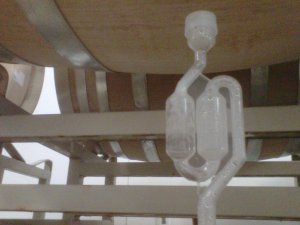
One of the little pleasures of making Chardonnay this way is getting to hear the little ‘blip blip blip’ of gas escaping out through the fermentation bungs. It’s always nice to hear them going in the mornings, it’s a sign that the fermentation is healthy and strong!
Additionally, we have ended the cold-soak on the Monte Rosso Zinfandel, and inoculated it with yeast as well.

To inoculate the crushed grapes, or ‘must’, we add a little bit of juice and a little bit of hot water to a bucket. We then add the freeze-dried yeast culture to the bucket and gently mix it until it has a smooth consistency. Almost immediately, the yeast wake up and begin to ferment, forming the cake of foam you can see in this picture. Once the yeast are rehydrated and happy, we pitch them over the top of the tank and let them go to work!
We estimate that this wine will have just around 15% alcohol when it’s done, so we chose a strong fermenting yeast that can handle alcohol in that range known as K1. This yeast is known for its’ clean character, and for its’ ability to suppress wild yeasts that can cause off-characters during fermentation.
Everything is looking great so far, and we’ve only just begun! Be sure to check back to see how we’re doing!

Amapola Creek is Richard Arrowoods’ latest winemaking project, to visit the Amapola Creek Winery main site, please click here.
Done receiving Chardonnay
September 12, 2012
Today was our last shipment of Belli Chardonnay. We took just over two and a half tons today, bringing our total for the season to just over seven and a half. The fruit looked and tasted great, lots of flavor without an excess of sugar.
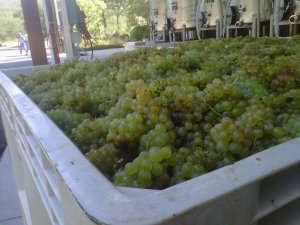
We’ve always found that the Belli Chardonnay attains flavor-ripeness at a relatively low sugar, which means that we can make a wine with intensity of flavor that we want in a lower-alcohol, more Burgundian style. If you look closely in this picture, you can see some small brown regions on several of the clusters. This is a phenomenon known as ‘sunburn’. In large quantities sunburn can cause off flavors in the wine, but at a very low rate such as this it can actually contribute delicate caramel nuances to the finished product.
Now that Chardonnay is done for the year, we will move on to the Zinfandel. We’re letting the hang for a few more days to let the acid drop a little bit, but we still have plenty to do in the meantime, be sure to check back and follow along!

Amapola Creek is Richard Arrowoods’ latest winemaking project, to visit the Amapola Creek Winery main site, please click here.
Here we go…
September 11, 2012
Today we continued receiving Chardonnay from the Belli ranch in the Russian River. We finished out the Rued clone from block 3 yeasterday, and today we had the pickers move in to block 5, which is planted to Dijon clone 76.
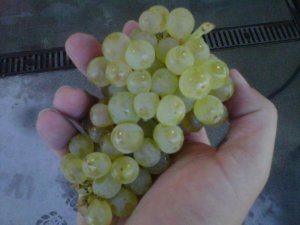
Dijon clone 76 is a classic French selection of Chardonnay, which grants acidity and structure to the final blend, along with characters of pear, stone fruit, and minerality. Rued clone has small, loose clusters, while clone 76 tends to have larger clusters that are relatively tight.
Our day began when Joe Belli rolled in with his load of grapes.

We received just slightly more today than we did yesterday. It looks and tastes beautiful, the sugars are not too high, which will allow us to make a very elegant, Burgundian style white.
Once the grapes were off the truck, we immediately loaded them into the hopper so we could get them into the press.
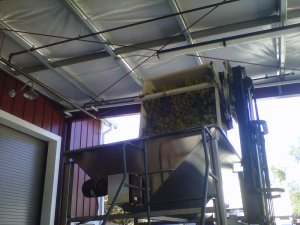
We received an odd number of bins, so to split the day into two even press loads we had to carefully dump only half of the fruit out of one of them into the hopper.
From the hopper it went to the press.

Dijon clone 76 is a little bit juicier than Rued, which made loading the press a little bit easier. By the time it was full, we had a steady flow of juice into the juice tray.
While the press was running, we ran over to our neighbor Monte Rosso and grabbed a sample of the Old Vine Zinfandel. Happily enough, we found that it will be ready to harvest this week!

As you can see, the juice from the Zin already has a deep, dark color to it. The flavors are already very characteristically Zinfandel, with layer upon layer of luscious red and black fruit. We are very excited to have access to these special grapes!
We will continue tomorrow with the last bit of the Belli Chardonnay. Be sure to check back to check it out!

Amapola Creek is Richard Arrowoods’ latest winemaking project, to visit the Amapola Creek Winery main site, please click here.
Harvest 2012 has begun!
September 10, 2012
Last Friday we finally received our first load of grapes for the 2012 season!

To keep the grapes as cool as possible, the pickers started working at dawn. Joe Belli rolled in with his beautiful Chardonnay at around 10:30 Friday morning.
The fruit looks fantastic, and it tastes great as well.

These grapes are from block 3, which is planted to the Rued clone of Chardonnay. Rued is a musque selection of Chardonnay, meaning that it has just a touch of Muscat character. For those of you not familiar, Muscat is a very fruity, tropical flavor, reminiscent of pineapples and papaya. Eating some of the Rued Chardonnay grapes every year is a treat we all look forward to!
Once the grapes were off the truck, we took a brief pause to bless the grapes.

This is a tradition that Richard started back in the first days of Arrowood Winery. Richard, his wife Alis, and his daughter Kerry pour just a little bit of the prvious vintage of Chardonnay over the grapes as a way of wishing for another great harvest!
Once the grapes were blessed, we took them and loaded them into the hopper, which in turn moved them into the press.

We ‘whole-cluster press’ our Chardonnay, meaning that we do not remove the grapes from the stems before we load them into the press. This is a gentler way of processing Chardonnay, which means that we will avoid extracting harsh tasting tannins into the juice.
We received just under two and a half tons today. We have a very small press, so two and a half tons means that we have to load it twice over the course of the day.

Whole cluster pressing means you can fit fewer grapes in the press at a time, so we really had to be careful to use all of the space in the press to make sure we could fit it all in two loads.
Once the press was loaded we sat back and watched the pristine Chardonnay juice run out into the juice tray.

The juice has a slight brownish color now because it is high in grape solids (the pulp of the grapes). We immediately pumped it to small holding tanks where we chilled it down to allow the solids to settle out before fermentation.
This is a very exciting time for us here at Amapola Creek, harvest is always busy and full of beauty. We will be harvesting more grapes this week, be sure to check back to see what we’re up to!
Amapola Creek is Richard Arrowoods’ latest winemaking project, to visit the Amapola Creek Winery main site, please click here.
The first pick is scheduled!
September 5, 2012
Today we went out and sampled the Chardonnay at the Belli ranch again. Block 3 (Rued clone, which is a slightly Musque, or Muscat, selection of Chardonnay) is always the first block to come in, so it’s the one we took the closest look at today. We asked Joe to turn down the irrigation last week, to let the flavor of the berries gain in concentration.

Once we start getting closer to the moment of harvest, we switch over from berry sampling to cluster sampling. Cluster sampling uses a much larger volume of fruit, and is therefore generally more accurate than berry sampling. Since this kind of testing is more accurate, it allows us to more finely tune our choice of harvest date.
The decreased irrigation coupled with the gorgeous weather we’ve been having gave us the result we were hoping for, the berries are tasting just at the edge of being ripe, and so we will begin harvest 2012 this Friday!
Now that we have a firm start date, we are beginning the last few preparations that we need to make. Since we will need the press on the day we receive the Chardonnay, today we got it set up and cleaned it inside and out.

The outside of the press has some dust on it, even though it’s been covered since last year.
This is also our chance to make sure that the press is operating the way it’s supposed to. Once the grapes are here we will need to process them as quickly as possible, so if there’s anything wrong with the press we need to know about it ahead of time.

The inside of the press needs to be as clean as possible, so we rinse it thoroughly with a solution of sodium percarbonate, which kills any microorganisms which may have carried over from last year. To make sure the coverage is thorough, we let the solution collect in the juice tray and then pump it up into the press itself, repeating the process several times.
Everything is looking pretty good, the equipment is clean, it works, and some unbelievably delicious grapes are on the way. We’re really looking forward to this harvest, please follow it with us here on the blog!
Amapola Creek is Richard Arrowoods’ latest winemaking project, to visit the Amapola Creek Winery main site, please click here.
Berry Sampling
August 21, 2012
We took another trip out to the Russian River Valley this week to see how the Belli Chardonnay was progressing. As you may be aware, the current weather, with daytime temperatures in the 90’s and nighttime temperatures in the 50’s, is highly conducive to ripening. The Rued clone block at the Belli ranch is cropped very lightly, and it’s placed on a steep hillside with very well-drained soil, and so what we’re finding is that this block is developing very rapidly indeed.

As you can see, some of the vines in the Rued block at the Belli ranch have very little fruit on them, sometimes only 3 or 4 small clusters. This results in grapes that are extremely intensely flavored.
To figure out exactly how far along a block of grapes is, we use ‘berry sampling’. This technique is pretty much exactly what it sounds like; we walk through the vineyard and pick individual berries to form a composite sample that represents the block as a whole. Doing this well can actually be a little bit tricky. Berries need to be picked from random spots throughout the canopy, or you run the risk of skewing your results.

For instance, grapes that are tucked away inside the canopy (like on the right-hand side of this picture) receive less sunlight and are likely to be less ripe. More exposed clusters (like in the center of this picture) are likely to be more ripe. You have to make sure you pick a mixture of both exposed and hidden berries to get an accurate cross-section of the whole vineyard, or else risk picking at the wrong time.
After todays’ sample (assuming the weather holds), it looks like we’re about two weeks out from picking the first few tons of Belli Chardonnay. Predicting exact pick dates is a little dodgy, but these grapes are gaining sugar so quickly that it would be very surprising if the pick came very long after labor day. Be sure to check back to see what we’re up to next!
Amapola Creek is Richard Arrowoods’ latest winemaking project, to visit the Amapola Creek Winery main site, please click here.
Checking out the Belli Chardonnay
August 13, 2012

Today we headed over to the Russian River Valley to check out our Chardonnay, which comes from the Belli Ranch,

The Belli ranch is located at the Northern end of the Russian River Valley, where the valley floor starts to lift up into foothills. The excellent drainage and southeastern facing slope make for tiny berries that are very intense in flavor.
It’s still pretty early in the season, but we’re already seeing some maturity in the Rued clone, which is planted in blocks 3 and 5, along the left hand side of the picture above.
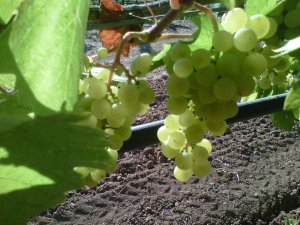
You can tell these grapes are starting to mature visually by their slight yellow color and slight translucence. Rued clone is a Musque selection of Chardonnay, meaning that it has a slight flavor of Muscat, which is slightly tropical in nature. This character is faint right now, but it is definitely beginning to show and will increase in intensity as we approach harvest.
The rest of the Chardonnay is further behind in terms of ripeness. The other blocks are older, and the vines are more established. They carry more fruit, and so are ripening more slowly than the Rued blocks.

This is clone 76, a Dijon selection that provides a very classic Chardonnay profile of pear, citrus, and minerality. This cluster is visibly underripe, you can tell by its’ dark green color. The fruit is starting to sweeten, but harvest for this block is still some way off.
We are currently looking at some very hot weather in Sonoma (mid 90’s through the weekend at least!), so we’re expecting to see ripeneing progress rapidly. Over the next few weeks, we’re expecting our posts to become more and more frequent as there becomes more and more action to cover, be sure to stay caught up!
Amapola Creek is Richard Arrowoods’ latest winemaking project, to visit the Amapola Creek Winery main site, please click here.
A great review for our 2010 Chardonnay!
May 8, 2012

Anthony Diaz Blue had some very nice things to say about our current release 2010 Jos. Belli Chardonnay!
“90: Amapola Creek 2010 Chardonnay, Jos Belli Vineyards, Russian River Valley ($35) A lush, ripe Chard from Sonoma master Richard Arrowood; dense fruit and firm acidity; unfined for rich complexity, depth and lengthy flavors; stylish and vivid.”
As always, it’s great to hear that someone appreciates all of the hard work we put in on our wines!
To visit the Amapola Creek Winery main site, please click here.
Announcing the release of the 2010 Jos. Belli Chardonnay!
March 14, 2012
Here at Amapola Creek, we have historically focused our efforts on classic Bordeaux and Rhone red varieties. However, when we found we had a chance to get our hands on some Russian River Chardonnay from grower Joseph Belli in 2010, we knew we had an opportunity not to be missed.
This wine is stunning, and we only produced 210 cases of it. Be sure to check it out before it’s all gone!
To visit the Amapola Creek Winery main site, please click here.
Stirring the Chardonnay
December 1, 2011

We put the Belli Chardonnay down to barrel just about six weeks ago. Once the wine is in barrel, the last little bit of solids (almost entirely dead and dying yeast cells) have time to settle out. This makes the wine nice and clear, but in fact at this stage we actually want the wine to get a little bit of contact with the remaining yeast cells. This improves the mouthfeel of the wine, and tends to add subtle warm, nutty characters to the mid-palate. As the yeast cells break down (a process known as autolysis that usually starts around six months after the fermentation is over) they also tend to generate a rich, creamy character that is highly desirable in our style of Chardonnay.
To keep the yeast suspended in the wine, we stir the barrels, a process also known as batonage.

- This is the baton that gives batonage its’ name. Colloquially, it is known as a stirring wand. The wand is inserted into each barrel, and then it is drawn vigorously from side to side so that the hinged plate at the end drags along the bottom, stirring the yeast up into the wine.
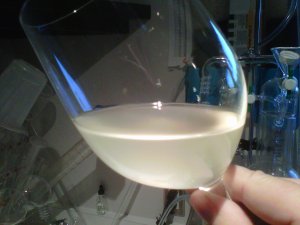
- This wine was fairly clear before we stirred it earlier today, but notice how much the yeast have been stirred up off of the bottom of the barrel. This is how we would like the wine to spend most of it’s time looking during this stage of the process.



